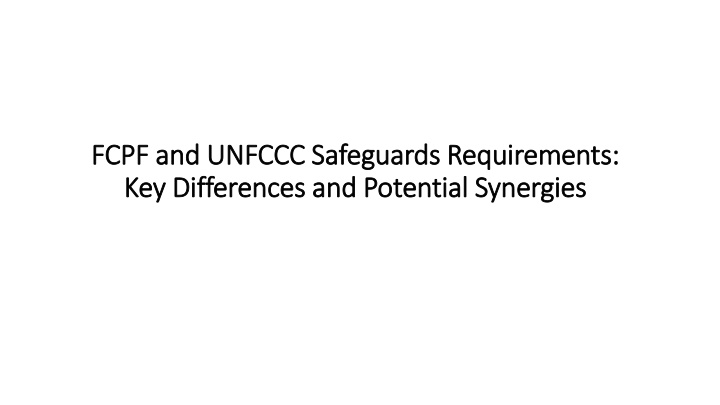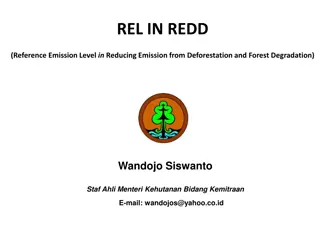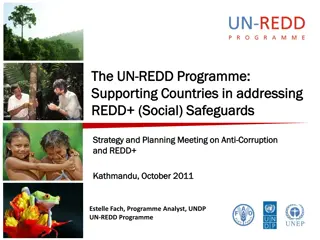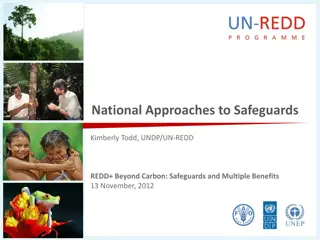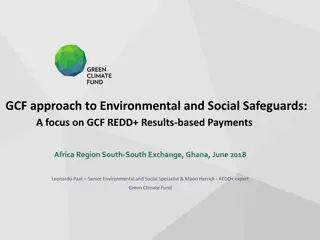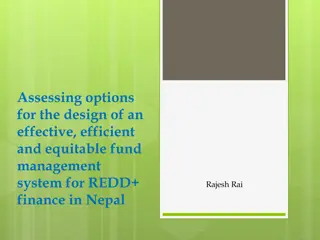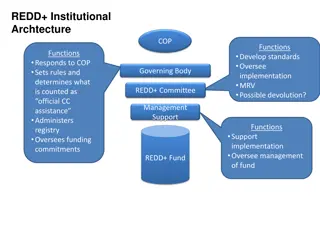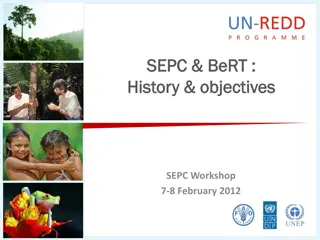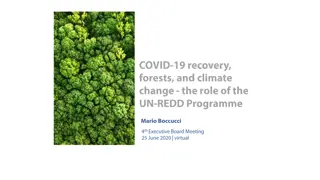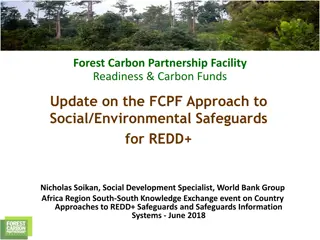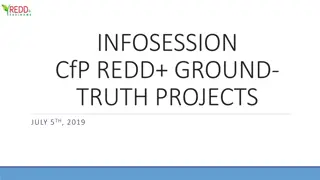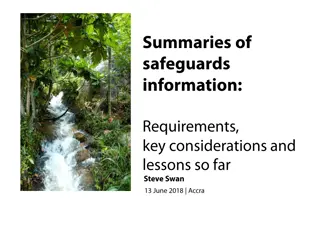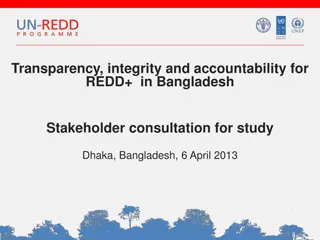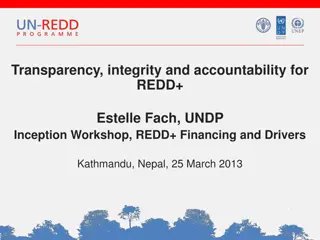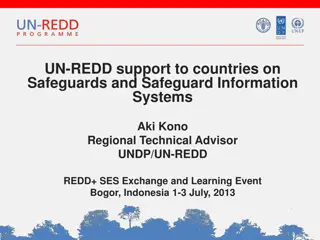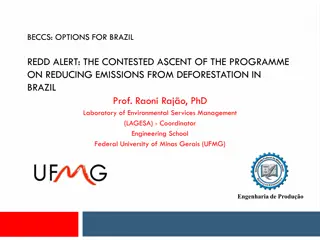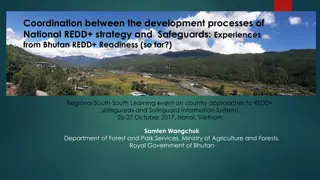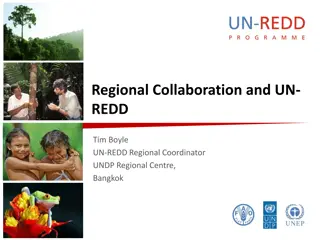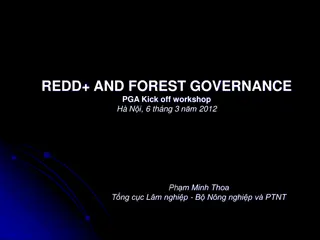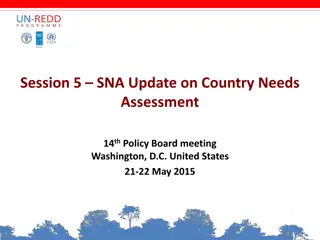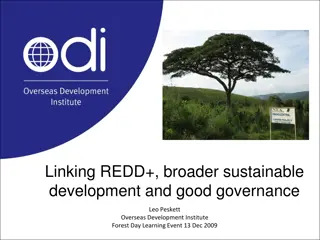Safeguard Requirements in REDD+ Implementation: UNFCCC and FCPF Perspectives
Safeguard requirements in REDD+ projects involve various approaches and processes from entities like bilateral donors, the Green Climate Fund, project-level standards, and more. The challenge lies in integrating these multiple requirements into a coherent national approach to ensure efficiency and resource optimization. The UN-REDD Programme advocates for a consolidated country-specific approach to safeguards. Both the UNFCCC and FCPF provide frameworks for addressing and promoting safeguards at national and project levels.
Download Presentation

Please find below an Image/Link to download the presentation.
The content on the website is provided AS IS for your information and personal use only. It may not be sold, licensed, or shared on other websites without obtaining consent from the author.If you encounter any issues during the download, it is possible that the publisher has removed the file from their server.
You are allowed to download the files provided on this website for personal or commercial use, subject to the condition that they are used lawfully. All files are the property of their respective owners.
The content on the website is provided AS IS for your information and personal use only. It may not be sold, licensed, or shared on other websites without obtaining consent from the author.
E N D
Presentation Transcript
FCPF and UNFCCC Safeguards Requirements: FCPF and UNFCCC Safeguards Requirements: Key Differences and Potential Synergies Key Differences and Potential Synergies
Significant Challenge to REDD+ Safeguards Significant Challenge to REDD+ Safeguards Multiple safeguard requirements and approaches (bilateral donors, GCF (potentially), project-level standards, REDD+ SES, WB-FCPF, regional development banks, UNFCCC, etc.) are: Seen as confusing and burdensome by countries Result in inefficiency in the use of resources and creation of parallel processes These multiple processes could be integrated into a country approach to safeguards, an approach that the UN-REDD Programme supports
Safeguard Requirements: UNFCCC and FCPF Safeguard Requirements: UNFCCC and FCPF CONTENT PROCESS OUTPUTS Safeguard information system (SIS) to provide information on how the country is addressing and respecting the Cancun safeguards Summary of information on how the Cancun safeguards are being addressed and respected submitted before results-based payments OUTPUTS National level None specified Countries promote and support the Cancun safeguards throughout REDD+ implementation UNFCCC PROCESS CONTENT Readiness Fund Common Approach to Environmental and Social Safeguards gives process Countries apply relevant World Bank safeguards gives content Countries apply guidance on o Stakeholder Engagement o Grievance Mechanisms National and subnational level Strategic Environmental and Social Assessment (SESA) Environmental and Social Management Framework (ESMF) FCPF Associated Management Plans (e.g. IPs, resettlement, biodiversity, etc.) Carbon Fund WB safeguards Safeguard Criteria & Indicators in Methodological Framework 1
Safeguard Requirements: UNFCCC and FCPF Safeguard Requirements: UNFCCC and FCPF CONTENT CONTENT - - COMPARISON COMPARISON UNFCCC FCPF Readiness Fund Countries apply relevant World Bank safeguards throughout REDD+ implementation Countries promote & support the Cancun safeguards throughout REDD+ implementation OP 4.01 Environmental Assessment OP 4.04 Natural Habitats Consistency with national forest programmes and international conventions and agreements a) OP 4.36 Forests OP 4.12 Involuntary Resettlement Transparent and effective national forest governance structures b) OP 4.10 Indigenous Peoples Countries apply Guidance on Stakeholder Engagement and Grievance Mechanisms Respect for the knowledge and rights of indigenous peoples/local communities c) FCPF Carbon Fund Full and effective participation of relevant stakeholders d) In addition to Readiness Fund requirements, Methodological Framework criteria and indicators related to: Promoting and supporting the UNFCCC safeguard requirements Taking into account applicable international law An operational grievance mechanism An assessment of land and resource tenure regimes Strategies to identify, prevent and minimize risk of reversal Conservation of natural forests and biodiversity enhancing other benefits e) Actions to address the risks of reversals f) Actions to reduce displacement of emissions g)
Safeguard Requirements: UNFCCC and FCPF Safeguard Requirements: UNFCCC and FCPF CONTENT CONTENT - - ANALYSIS ANALYSIS FCPF Readiness Fund DIFFERENCES SIMILARITIES Greater level of detail and specificity contained within the WB safeguards as compared to the Cancun safeguards. Cancun safeguards emphasize the do good aspect of safeguards more than the WB safeguards, which focus more on a do no harm risk management approach Cancun safeguards reference consistency with applicable international law, which the WB safeguards do not, but the CFMF does FCPF Carbon Fund Although actual degree of equivalence depends on how each country clarifies the Cancun safeguards, there is general consistency among the Cancun safeguards and the WB safeguards Unlike the CFMF, UNFCCC doesn t require: General consistency among the following Cancun safeguards: a) Consistency with national forest programmes and international conventions a GRM be established, though a country could interpret it as part of Cancun safeguard (b) tenure assessments, though a country could interpret it as part of Cancun safeguard (b) a mechanism be established for management of reversals that take place, though a country could interpret it as part of Cancun safeguard (f) c) Respect for the knowledge and rights of indigenous peoples/local communities d) Full and effective participation of relevant stakeholders e) Conservation of natural forests and biodiversity enhancing other benefits Unlike the CFMF, UNFCCC doesn t reference title to emissions reductions
Safeguard Requirements: PROCESS & OUTPUT Safeguard Requirements: PROCESS & OUTPUT - - COMPARISON COMPARISON FCPF COMMON APPROACH Strategic Environmental and Social Assessment & Environmental and Social Management Framework COUNTRY APPROACH TO SAFEGUARDS Conceptual framework to meet UNFCCC requirements (UNFCCC specifies no specific process) Diagnostic work - drivers of deforestation and forest degradation and associated environmental/social issues, e.g. land tenure, resource access Define safeguards goals & scope Assessment of legal, policy and institutional frameworks for REDD+ - i.e. PLRs Identify, assess & strengthen policies, laws & regulations (PLRs) Identify, assess & strengthen systems and sources of information Identify, assess & strengthen institutional capacity to implement PLRs Assessment of existing capacities and gaps to address the environmental and social issues identified Integration of environmental and social issues identified into the REDD+ strategy options - i.e. PAMs Safeguard information system Safeguards respected Safeguards addressed Development of frameworks to mitigate and manage the risks of the REDD+ strategy options, to be included in an ESMF Summary of information Establish outreach, communication and consultative mechanisms with relevant stakeholders for each step
Safeguard Requirements: UNFCCC and FCPF Safeguard Requirements: UNFCCC and FCPF PROCESS & OUTPUT PROCESS & OUTPUT - - ANALYSIS ANALYSIS UNFCCC does not outline a specific process Country approaches to UNFCCC to safeguard requirements are consistent with national policy goals and existing, PLRs, institutional arrangements, information systems, etc. Country approaches to safeguards could be generally consistent with the FCPF Common Approach to Safeguards (SESA/ESMF), with some notable similarities and differences DIFFERENCES SIMILARITIES Country approaches enable national ownership through interpretation of Cancun Safeguards; while FCPF requires adherence to the pre-set WB OPs. Both approaches: Have similar objectives, including a) assessing social and environmental impacts of a country s national REDD+ strategy, PAMs and/or priority REDD+ actions; and b) developing strategies and measures to address the potential impacts Unlike FCPF, country approaches incorporate focus on development of an SIS, in line with UNFCCC guidance Unlike FCPF, country approaches incorporate focus on development of summaries of information, in line with UNFCCC guidance Prioritize stakeholder engagement throughout the process 4 convergent steps (see slide 10) benefit/risk assessment; PLR assessment; institutional assessment; plans to manage benefits/risks Country approaches to safeguards incorporate planning benefit/risk management as integral elements of their NS/APs; whereas FCPF ESMF comprises a set of standalone safeguards plans
UNFCCC Identify policies and measures (PaMs) Plan for managing benefits and risks of PaMs Assess benefits and risks of PaMs Determine drivers (& barriers) National strategy/action plan (NS/AP) Clarify Cancun safeguards in country context Assess existing policies, laws and regulations (PLRs) Revise existing (develop new) PLRs Safeguards addressed Strengthen capacity to implement PLRs Define safeguard goals and scope Assess capacity to implement PLRs Safeguards respected Determine information needs and structure (e.g. indicators) Assess existing information systems & sources Safeguard Information System Define SIS objectives Summary of information Stakeholder engagement
UNFCCC Identify policies and measures (PaMs) Plan for managing benefits and risks of PaMs Assess benefits and risks of PaMs Determine drivers (& barriers) National strategy/action plan (NS/AP) Assess existing policies, laws and regulations (PLRs) Clarify Cancun safeguards in country context Revise existing (develop new) PLRs Safeguards addressed Define Assess capacity to implement PLRs Strengthen capacity to implement PLRs Safeguards respected safeguard goals and scope Determine information needs and structure (e.g. indicators) Assess existing information systems & sources Integration of different safeguard requirements Safeguard Information System Define SIS objectives Summary of information Stakeholder engagement
UNFCCC Identify policies and measures (PaMs) Plan for managing benefits and risks of PaMs Assess benefits and risks of PaMs Determine drivers (& barriers) National strategy/action plan (NS/AP) Assess existing policies, laws and regulations (PLRs) Clarify Cancun safeguards in country context Revise existing (develop new) PLRs Safeguards addressed Define Assess capacity to implement PLRs Strengthen capacity to implement PLRs Safeguards respected safeguard goals and scope Determine information needs and structure (e.g. indicators) Assess existing information systems & sources Safeguard Information System Define SIS objectives Summary of information Stakeholder engagement
Summary: Synergies and Differences Key Findings General consistency among the Cancun safeguards and the WB safeguard requirements of the Readiness Fund Particular differences between UNFCCC and FCPF Carbon Fund are primarily related to Carbon Fund requirements on: Transfer of title/title to ERs Tenure assessments Grievance redress mechanism Reversal management mechanism Level of consistency is dependent on country clarification of safeguards Multiple requirements and processes can, in theory, be integrated into a single country approach to safeguards Advantages of FCPF Common Approach Advantages of country approaches Country ownership over clarifying safeguards in a national context Emphasis on ensuring consistency with international obligations More focus on meeting UNFCCC requirements related to SIS and summaries of information More details and specificity on what each WB safeguard means and how to apply it effectively More detailed guidance on the development of management plans to address key social and environmental impacts of REDD+ actions
Realising Synergies and Optimising Realising Synergies and Optimising Complementarities Complementarities FCPF and UN-REDD staff need to understand each other s approaches, together with the synergies, differences and areas for enhancing complementarity Differences in substantive content between UNFCCC and WB safeguards need not be a barrier to complementarity and mutually supportive processes Degree of complementarity of processes will also depend on the scope, timing and sequencing of SESA-ESMF vis- -vis the process to develop the national REDD+ strategy/action plan
